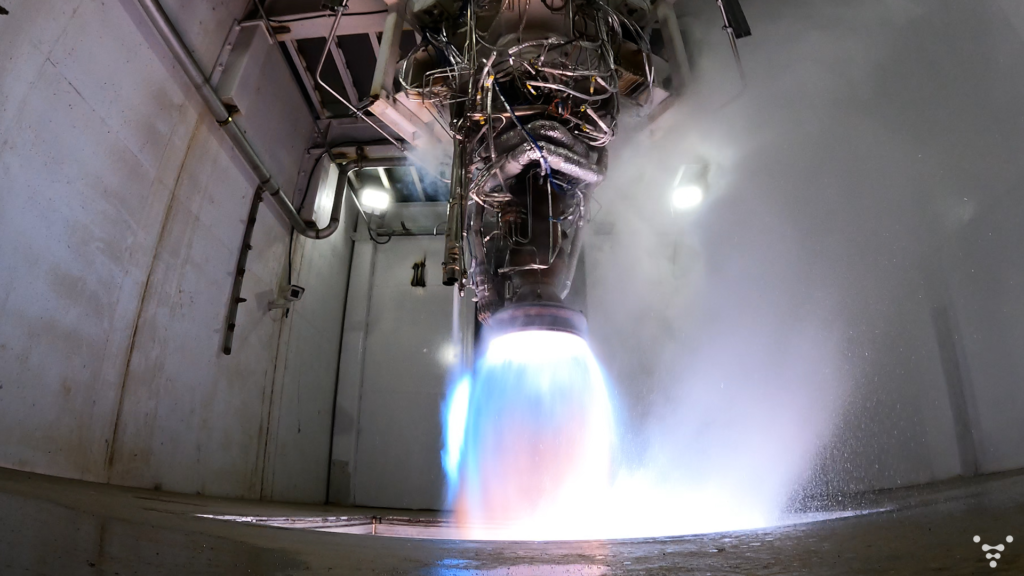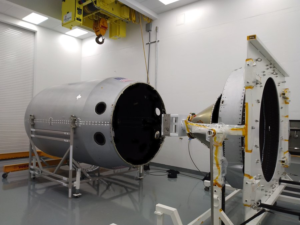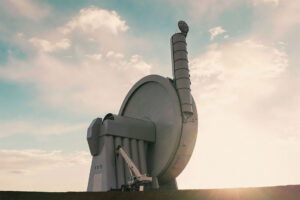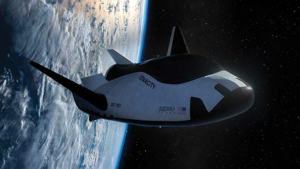
Relativity Space Just Tested The First Full-Scale Aeon R Engine
Relativity Space is moving faster than ever before with work on both Terran 1’s first flight and Aeon R progress. Over the last couple of months, we have watched as the company released somewhat consistent updates on the next generation launch vehicle hoping to be both fully reusable and fully 3D printed. Combine this with its massive size and Terran R could be the future of accessing space.
In terms of progress, yesterday CEO of Relativity Tim Ellis provided new details of the first full scale Aeon engine testing. What’s so impressive is the speed at which these developments are being made in conjunction with the first flight of Terran 1 around the corner. One of the most complex and important components of any rocket is its main engines.
Each Aeon R is expected to produce around 268,000 pounds of maximum thrust when operational. Enough of these on the first stage and all of a sudden you have a very powerful launch vehicle with an impressive payload capacity. Here I will go more in-depth into yesterday’s milestone, why it’s so important, what to expect in the future, and more.
Full-Scale Aeon R Test

Yesterday we received one of the most significant updates related to Terran R when Tim Ellis tweeted saying, “This may look like all our other engine tests but it’s not… first Aeon R full-scale hot fire test! goal by the team, this was 35% power level of the 268,000 lb max thrust. These brand new 3D printed engines will power Terran R. Massive push to get this done so quickly.” He also commented that “I am certain this is among the fastest blank sheet to tested hardware at this rocket propulsion scale to ever happen. Maybe THE fastest.”
Currently, Relativity is in process of building the first full engine with turbopumps, and will begin testing w/ pumps next year. This thrust chamber assembly testing will help them get regen, injector, and performance data which is key. In terms of the design, Relativity’s engines, Aeon 1, Aeon R, and Aeon Vac, are 3D-printed, expected to enhance mission reliability by reducing part count in engine combustion chambers, igniters, turbopumps, reaction control thrusters, and vehicle pressurization systems. All Aeon engines including Aeon R use liquid oxygen plus liquid natural gas, which are not only one of the best for rocket propulsion, but also the easiest to eventually make on Mars. Terran R will feature 7 Aeon R engines on the first stage and single Aeon Vac on the second stage. With initial launches of the rocket scheduled for 2024, this fast progress is helping keep the company’s ambitious time frame within reach.
Following the busy theme, Relativity provided even more important updates in the last couple of days. On December 16th they tweeted mentioning, “Over at @NASAStennis watch an Aeon R engine stand and water tower go. As a part of our 150+ acre expansion dedicated to Aeon R engine testing, this stand will be home to many hot fires.” This included a short video timelapse of the build progress. Just a few months ago in October, it was revealed that Relativity Space planned to build comprehensive facilities in the Stennis Test Complex to test its Aeon R engines. The company envisions the completed project as one of the largest commercial test facilities in the nation. The Mississippi Development Authority is working with Relativity Space to assist with the project. Stennis, located near Bay St. Louis, Mississippi, will provide a range of site services as part of the partnership agreement. The test stand at Stennis highlights that the company is making impressive progress on not only the engine but also its necessary infrastructure.
Another important test in relation to these engines is the first launch of Terran 1. While this rocket uses a different smaller type of engine, a lot of its qualities are shared with Terran R and its components. For perspective, Aeon R is a decent bit bigger than Aeon 1 and features over 10x thrust. Images of the chambers make this clear however the pumps are disproportionally larger due to the pressures and power density involved.
Terran R Progress

Now that we know more about Aeon R engine progress and some of its recent tests, we can take a closer look at the rocket these engines will power and some of the additional infrastructure being built. By fusing 3D printing, artificial intelligence, and autonomous robotics, Relativity is printing its rockets’ structure and engines. This process is hoping to significantly reduce touch points and lead times, simplify the supply chain, and increase overall system reliability. Relativity is confident that it can create its rockets, Terran 1 and Terran R, from raw material within 60 days. Terran R is fully reusable including its engines, first stage, second stage, and payload fairing, and will be capable of launching over 20,000kg to low Earth orbit (LEO) in a reusable configuration. As partially mentioned prior, Terran R is expected to launch from Cape Canaveral, starting in 2024.
For months now, we have watched as more and more focus has been put on this next generation rocket and it needs to be developed, tested, and manufactured. For example, over at Stennis, Relativity Space is already clearing ground for the construction of several new facilities. Company plans call for construction of new engine test stands, office buildings, and a vehicle facility. The company already is housed in several other locations within the Stennis test complex. It also has existing agreements to test its engines and rocket components on various Stennis test stands. Relativity Space originally partnered with Stennis to test its Aeon 1 engine on the site’s E-3 Test Stand. The partnership quickly expanded in 2018 to grant Relativity Space exclusive use of the E-4 Test Complex at Stennis.
The latest partnership agreement focuses on 153 acres located near the E-4 Test Complex and provides the company room to grow its operations for Terran R. By now, Relativity Space already has conducted 2,000+ hot fire tests at Stennis for their development.
Not to mention, earlier this year, Relativity announced today that it had signed a multi-year, multi-launch Launch Services Agreement (LSA) with OneWeb. Under the agreement, Relativity will launch OneWeb’s low Earth orbit (LEO) satellites on Terran R, starting in 2025. These launches will support OneWeb’s deployment of its Gen 2 satellite network, which will add capacity and fresh capabilities to build upon the initial constellation of 648 satellites the company is currently building out.
Terran R will launch OneWeb missions from Launch Complex 16, Relativity’s site at Cape Canaveral Space Force Station, where Terran 1 is set to launch from in the coming weeks. As a medium-heavy lift, fully reusable launch vehicle made for growing satellite constellation launch demand and eventually multiplanetary transport, Terran R is meant to provide both government and commercial customers affordable access to space, in LEO and beyond. With the addition of its multi-launch agreement with OneWeb, Relativity has a total of five signed customers for Terran R, including multiple launches and totaling more than $1.2B in backlog. At the time, Tim Ellis commented, “We are honored to be chosen by OneWeb to help launch their Gen 2 constellation. They have an incredible team, technology, and momentum as a world leader in satellite connectivity with hundreds of operational satellites already in orbit. It is clear that more disruptive launch capacity is needed in the marketplace – Relativity is developing Terran R to fill this additional demand. We cannot wait to plan, execute, and successfully launch these missions together with OneWeb!”
In addition to all this progress, Relativity is continuing to work on its next generation 3D printers. The newest Stargate printer technology defies traditional printing constraints by moving horizontally as it feeds multiple wires into a single print head to print orbital rockets. Relativity is developing customized software and machine learning techniques to allow these printers to print more complex and significantly larger metal products, with improved print speed and reliability. The new Stargate printers also radically simplify manufacturing supply chains, as they are capable of printing a rocket with 100x fewer parts in a matter of months.
Current Stargate printers improve on their predecessors and offer 7x faster than earlier generation Stargate printers and even achieve up to 12x faster printing over Relativity’s already industry-leading performance. They also remove ceiling height constraints which impact vertical 3D printers. Through horizontal printing, these printers are capable of printing objects up to 120 feet long and 24 feet wide, resulting in an increased volume capacity of 55x its 3rd generation predecessor. Reduced print start time and cost is also supported by an integrated approach to build setup and print plate preparation. All of which support the Terran R program and its future.
Conclusion
Relativity Space is moving extremely fast on a bunch of different projects. Even though the company’s first ever orbital test flight is only weeks away, more updates are coming out on Terran R including a new milestone for the Aeon R engine. If this pace keeps up the company will have full rocket tests scheduled to happen around the corner. We will have to wait and see how it progresses and the impact it has on the space industry.



